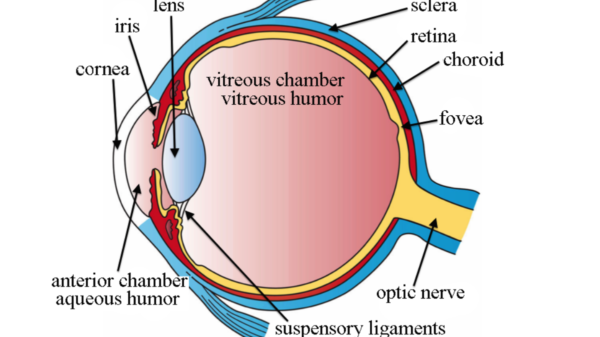Understanding the Basics of Your Eye: Anatomy and Function

- Cornea: The cornea is the transparent outer layer of the eye that covers the iris and pupil. It helps to refract light and focus it onto the retina.
- Sclera: The sclera is the white outer layer of the eye that protects the inner structures of the eye.
- Iris: The iris is the colored part of the eye that surrounds the pupil. It helps to control the amount of light that enters the eye by constricting or dilating the pupil.
- Pupil: The pupil is the black, circular opening in the center of the iris. It controls the amount of light that enters the eye by constricting or dilating it in response to the amount of light in the environment.
- Lens: The lens is a transparent structure behind the iris that helps focus light onto the retina. It changes shape to adjust the focus of the eye.
- Retina: The retina is a layer of light-sensitive cells at the back of the eye that converts light into electrical signals. These signals are then transmitted to the brain via the optic nerve.
- Optic nerve: The optic nerve is a bundle of nerve fibers that carries the electrical signals from the retina to the brain, which are interpreted as visual images.
The eyes are essential for vision and are a complex and delicate system that requires regular care and attention. If you have any concerns about your eyes or vision, you must see an eye doctor for a thorough evaluation and treatment.
Understanding the Role of Aqueous Humor in Maintaining Healthy Vision
Aqueous humor is a clear, watery fluid found between the cornea and the lens in the front part of the eye. It is produced by cells in the ciliary body, which is located behind the iris. Aqueous humor plays several crucial roles in the eye, including:
- Maintaining the shape of the eye: Aqueous humor helps to keep the eye round and maintain the distance between the cornea and the lens.
- Providing nutrients to the eye: The aqueous humor helps to deliver nutrients to the cornea and the lens, which are essential for maintaining healthy eye tissue.
- Regulating intraocular pressure: Aqueous humor helps to regulate the pressure inside the eye, which is vital for maintaining healthy vision.
- Refracting light: Aqueous humor helps to refract light as it passes through the eye, which helps to focus images on the retina.
Problems with the production or drainage of aqueous humor can lead to conditions such as glaucoma, a leading cause of blindness. You must see an eye doctor for a thorough evaluation and treatment if you have any concerns about your aqueous humor or eye health.
What is Vitreous Humor?
Vitreous humor is a clear, gel-like substance that fills the space between the lens and the retina of the eye. It is composed mainly of water, with small amounts of proteins, sugars, and electrolytes. The vitreous humor helps to maintain the shape of the eye and provides support for the retina. It also helps to refract light as it passes through the eye, which helps to focus images on the retina.
The vitreous humor is produced by cells in the eye called retinal pigment epithelial cells located in the posterior part of the eye. It is a relatively stable substance and does not regenerate or change much over time.
However, as we age, the vitreous humor may shrink and become more fluid, which can cause it to detach from the retina. This condition is called a posterior vitreous detachment, which can sometimes cause floaters or flashes in the field of vision.
Vitreous Humor Function
The main functions of vitreous humor are to:
- Maintain the shape of the eye: The vitreous humor helps to keep the eye round and maintains the distance between the lens and the retina, which is vital for good vision.
- Provide support for the retina: The vitreous humor helps to keep the retina in place and prevents it from sagging or moving out of position.
- Refract light: The vitreous humor helps to refract light as it passes through the eye, which helps to focus images on the retina.
- Protect the eye: The vitreous humor helps to protect the eye from injury by acting as a shock absorber and cushioning the eye from impacts.
- Regulate the temperature of the eye: The vitreous humor helps regulate the eye’s temperature by absorbing heat and dissipating it to the surrounding tissues. This helps to maintain a constant and optimal temperature for the eye.
Does the Age Affect its Composition?
As we age, the vitreous humor may change in composition and structure. In particular, the vitreous humor may shrink and become more fluid with age. This process is called liquefaction, a normal part of the aging process.
The vitreous humor comprises water and a small amount of proteins, sugars, and electrolytes. As we age, the proteins and sugars in the vitreous humor may break down and become more diluted, which can cause the vitreous humor to become more fluid. This process is more likely to occur in older people or with certain medical conditions, such as diabetes.
In some cases, the liquefaction of the vitreous humor can cause it to detach from the retina. This is called a posterior vitreous detachment, which can sometimes cause floaters or flashes in the field of vision. In most cases, a posterior vitreous detachment is not a serious condition and does not require treatment. However, if you experience floaters or flashes in your vision, you must see an eye doctor to rule out any other underlying causes.
What Diseases Can Affect Vitreous Humor?
Several diseases and conditions can affect the vitreous humor and cause changes in its structure and function. Some examples include:
- Diabetic retinopathy: People with diabetes are at increased risk of developing diabetic retinopathy, which can cause changes in the vitreous humor. In particular, the vitreous humor may become more fluid and detach from the retina, leading to floaters or flashes in the field of vision.
- Uveitis is an inflammation of the uvea, which is the eye’s middle layer. It can cause swelling and scarring in the vitreous humor, leading to changes in vision.
- Retinal detachment: A retinal detachment occurs when the retina becomes separated from the back of the eye. It can be caused by various factors, including a posterior vitreous detachment, trauma, or inflammation. Retinal detachment can cause vision changes and can be a severe condition that requires prompt medical attention.
- Posterior vitreous detachment: As mentioned earlier, a posterior vitreous detachment occurs when the vitreous humor detaches from the retina. It is a common condition, especially in older people, and can cause floaters or flashes in the field of vision.
- Vitreous hemorrhage: A vitreous hemorrhage occurs when blood collects in the vitreous humor, typically due to a retinal detachment, trauma, or eye surgery. It can cause vision changes and may require treatment.
You must see an eye doctor for a thorough evaluation if you have any concerns about your vitreous humor or eye health. They can diagnose and treat any underlying conditions affecting your vision.
Vitrectomy Surgery: A Treatment Option for Conditions Affecting the Vitreous Humor
A vitrectomy is a surgical procedure that involves removing some or all of the vitreous humor, the gel-like substance that fills the space between the lens and the retina in the eye. Vitrectomy surgery is usually performed to treat conditions that affect the vitreous humor, such as a posterior vitreous detachment, vitreous hemorrhage, or retinal detachment.
Several techniques can be used for a vitrectomy, and the specific technique will depend on the treatment of the underlying condition. The surgery is generally performed using local anesthesia, and a small incision is made in the white part of the eye (the sclera). A special instrument called a vitrectomy probe is inserted into the eye through the incision, and it is used to remove the vitreous humor.
After the vitreous humor is removed, the surgeon may need to repair any damage to the retina or other parts of the eye. This may involve injecting a gas or silicone oil into the eye to hold the retina in place or laser surgery to seal any tears or holes in the retina.
Vitrectomy surgery can successfully treat many conditions that affect the vitreous humor, and it can often improve vision. However, like any surgery, it carries some risks, such as infection, bleeding, and damage to the eye. If you are considering vitrectomy surgery, discussing the potential benefits and risks with your eye doctor is essential.
Conclusion
The vitreous humor, the jelly-like fluid inside the eye’s posterior chamber that helps provide the eye its shape, serves an essential function in vision.
As people age, it is common to experience floaters due to changes in the vitreous. It is also possible for retinal tears and retinal detachment to occur due to changes in this gel-filled structure.
If you experience any vision-related problems or changes due to aging, it is essential to consult your ophthalmologist as soon as possible. A surgical procedure called a vitrectomy can help address issues related to vitreous humor.
It is recommended that individuals receive regular eye exams to diagnose and treat early any disease affecting their eye health.






